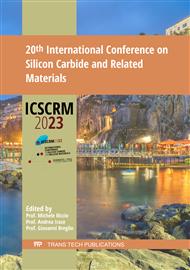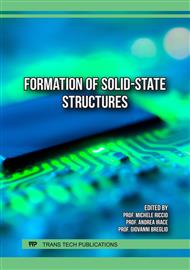p.13
p.21
p.29
p.35
p.41
p.47
p.53
p.59
p.65
Transient-Enhanced Diffusion of Implanted Aluminum in 4H-SiC
Abstract:
Semiconductor devices rely on the incorporation of donor and acceptor atoms into the crystal lattice to form locally doped regions. For dopant atoms incorporated into SiC by ion implantation, a high-temperature annealing step is required to achieve electrical activation. This annealing step is accompanied by redistribution of the implanted atoms. The influence of the annealing parameters on dopant redistribution is crucial when aiming for ever smaller device dimensions. In this work, we present a consistent analysis of the diffusion of Al implanted in 4H-SiC after high-temperature annealing at 1650 °C and 1800 °C for different annealing times. We identify the equilibrium diffusion coefficient at long annealing times from Al profiles obtained by SIMS analyses for both annealing temperatures. The temperature dependence is determined using an Arrhenius representation. This allows to quantify the equilibrium diffusion lengths for the actual temperature profiles, including heating and cooling rates. We find that the measured diffusion lengths for short annealing times are larger than expected from equilibrium diffusion and attribute the excess length to transient enhanced diffusion. Comparing the transient diffusion lengths of room-temperature and 500 °C-implanted samples, we conclude that the transient behavior is likely related to residual crystal damage induced during the implantation process.
Info:
Periodical:
Pages:
41-46
Citation:
Online since:
August 2024
Keywords:
Permissions:
Share:
Citation:



